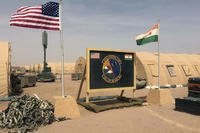There haven't been a lot of aircraft intercepts in the South China Sea even as tensions in the region become increasingly uneasy, a top Air Force general said Monday.
As China continues to build up contested islands in the region, U.S. Air Force strategic bombers such as the B-52 Stratofortress have not been overtly threatened during recent patrols, said Gen. Charles "CQ" Brown Jr., head of Pacific Air Forces Command.
There have been "very few intercepts of our bomber missions, but there's been intercepts of some of our intelligence aircraft," he said during a briefing with reporters at the Pentagon. The B-52 in recent weeks has made flights in the region.
"It's sporadic. It's not like every time we fly we get intercepted," Brown said, adding that some intercepts could be considered unprofessional but "not necessarily" unsafe. "It kind of ebbs and flows."
Related content:
- The Next B-52 Bomb Upgrade May Be a Tough Message for China
- China Leaving US Behind on Artificial Intelligence: Air Force General
- Russia Has Been Stalking US in Skies Over Syria, General Says
While air operations continue, U.S. leaders watch for more sophisticated threats, such as anti-ship missiles, electronic jammers and surface-to-air missile (SAM) systems, which continue to flow onto the islands.
For example, Indo-Pacific Command commander Adm. Phil Davidson last week said China is building up the number of SAMs in the region.
"What was a 'Great Wall of Sand' just three years ago is now a 'Great Wall of SAMs' in the South China Sea, giving the [People's Republic of China] the potential to exert national control over international waters," Davidson said during the U.S.Halifax International Security Forum on Nov. 17.
In his prior role as the Air Forces Central Command commander, Brown said he was familiar with the standard protocols U.S. pilots follow when a surface-to-air missile system "watches" their planes.
But even with the mass buildup of SAMs in the Pacific, "I haven't seen anything that's been provocative," nor anything to suggest SAMs have "locked onto" U.S. aircraft in recent months, he said.
"[There are] pretty capable SAM systems in Syria, but there wasn't intent to use those against the coalition. I would say the same thing in this case for right now in the South China Sea," Brown said. "But if tensions go up … we have a right to self-defense."
-- Oriana Pawlyk can be reached at oriana.pawlyk@military.com. Follow her on Twitter at @Oriana0214.














